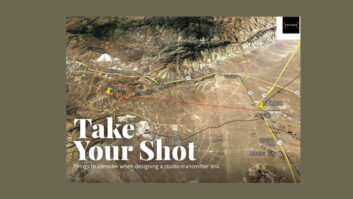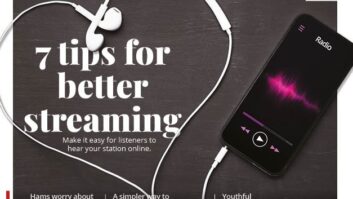The author is a former engineer at WCRB(AM/FM), WSSH and WFGL/WFMP. He has also been a contract engineer and a manufacturer of SCA receivers and EAS equipment for television.
I am opposed to the digitization of the AM broadcast band and believe it would be a mistake. I have six reasons.
The first is personal. In the 1950s when I was a boy, I built my first radio. It was a very simple crystal set. It consisted of a coil which I hand-wound, a cat-whisker galena detector and a headphone. There were no capacitors. Living 10 miles from the nearest station, which was only 1,000 watts, no single station was very strong so I picked up a number of stations. One night, I even picked up Radio Moscow and the BBC. This was the beginning of my lifelong interest in radio.
When I was in high-school, I got my amateur license and built a number of AM receivers and transmitters for the ham bands. Had it not been for that crystal radio, which would not have worked with digital, I might never have had a career in radio.
The second reason is the simplicity of making both receivers and transmitter. AM radio can never die, just as long as there are books that explain the technology. Anybody, with a little knowledge and a few tools, can make a decent AM radio with readily available discreet components. With a little more knowledge it is easy to build a low-power AM transmitter. AM radio will always be there and the parts are readily available.
[Letter to the Editor: AM Stereo Is Still an Option]
Despite my lifelong work, both in receivers and transmitters, I could not build a digital receiver or transmitter with discrete parts. I doubt that the proponents of digital radio could either. It is just too complicated. In order to make either, you need sophisticated microprocessors and there are only a few companies that make them, most of which are in Asia. If the supply from Asia were cut off, it might be five to 10 years before new consumer digital receivers could be built with processors made in the USA.
Our technology is becoming too complex. When I was a teenager and had my first car, I could repair just about anything. I could diagnose ignition problems, adjust the carburetor, check the timing, you name it! Today, if a car fails, it must be taken to a garage with sophisticated diagnostic tools, and the sensors cost a fortune to replace. Do we want the same with our AM radios?
The third reason why we should not go digital is because of the remarkable advancements in receiver technology. New receivers use digital signal processing (DSP) for all functions from antenna coil to recovered audio. Basically, DSP receivers heterodyne the incoming signal to a low frequency using an image-rejecting mixer. The signal is digitized and then demodulated by a virtual receiver that is mathematically ideal. The recovered audio in digital form is applied to a digital to analog converter, then amplified, and to the speaker. Within this ideal receiver is software to remove most unwanted impulse noise.
I tried Silicon Labs Si4770 AM/FM receiver chip and the reception is spectacular! Adjacent channel rejection is 57 dB. Signal to noise ratio for 30% modulation is 60 dB. Total harmonic distortion at 90% modulation is 0.2%. Receiver bandwidth adjustable is 100 Hz to 15 kHz in 100 Hz steps or automatic, based upon strength of desired and adjacent channels. Since the passband is nearly flat, that translates to an audio bandwidth up to 7,500 Hz. One surprise is that during periods of selective fading, there is no distortion.
[Read More Guest Commentaries Here]
If you want to hear what DSP sounds like, get into a fairly new car and listen to the AM radio because most new cars use DSP. A number of Asian companies are making DSP integrated circuits for AM/FM radio. They are cheap and the radios use only the loop antenna and no other coils or filters. There is consistent performance from receiver to receiver and no alignment. To select the frequency, the radios can use a microcontroller or a potentiometer attached to a ruler dial. Within a few years, all radios will use DSP and the problem of poor quality radios will cease to exist. Most important, the AM band will still be compatible with existing radios and technology.
The fourth reason for rejecting digital is the poor recovered audio quality of digital radio. I tried a trial version of professional DRM transmitter software. The software provider included a bug that causes the software to fail after three minutes use, and then it has to be reset. I downloaded the “Dream Receiver,” a PC computer based receiver, to evaluate reception. Thus, I could compare DRM to AM. The DRM was very clean. No noise could be heard at any usable signal level. But the audio did not sound as good as AM.
The fifth reason for rejecting digital is that the listener would lose some listening options. If you have two stations, one AM and the other digital, they will both be noise-free near the transmitters. As you move away from the transmitters, the AM signal will become noisy, but the digital will remain clear. At some point the digital will disappear, but the AM signal will still be usable, albeit noisy.
 I do not listen to a station because it is close or because it is strong, but because it has a program that I want to hear. I will tolerate some noise to listen to that program, but with digital, I will be forced to listen only to local stations whether I like the program or not, or I will not listen at all. Furthermore, sometimes stations fade in and out, partly because of propagation, but sometimes because of co-channel interference. If the station is AM, there will be a period of noise during the fade, but if it is digital, the station will cut out for the duration.
I do not listen to a station because it is close or because it is strong, but because it has a program that I want to hear. I will tolerate some noise to listen to that program, but with digital, I will be forced to listen only to local stations whether I like the program or not, or I will not listen at all. Furthermore, sometimes stations fade in and out, partly because of propagation, but sometimes because of co-channel interference. If the station is AM, there will be a period of noise during the fade, but if it is digital, the station will cut out for the duration.
Finally, most car radios will need to be replaced to permit digital reception. I intend to keep my car for at least ten years. Will I have to buy a new car just to get traffic reports and possible emergency information? Or will I have to purchase an expensive replacement radio and go through the misery of disassembling the dashboard to make the change?
I can find no valid reason to replace the AM band with digital. For most people, it will provide no significant improvement in quality. It will greatly reduce the range of many stations, especially clear-channel stations. The listeners will have fewer choices because they will be limited only to local stations.
Radio World invites industry-oriented commentaries and responses. Send to Radio World.












